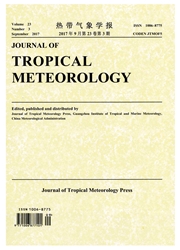

 中文摘要:
中文摘要:
Using the National Center for Environmental Prediction reanalysis data on 1.0°×1.0° grids and data from the Tropical Cyclone yearbook(2000),a diagnostic analysis and numerical simulation were performed to investigate the characteristics and mechanism underlying the rapid weakening of typhoon Xangsane.The results show that a sharp decline in the intensity of typhoon Xangsane resulted from its movement into the cool sea surface temperature area in the East China Sea,the intrusion of cold air from the mainland into the typhoon,and a rapid increase of the vertical wind shear in the surrounding environment.An important factor that led to the demise of the typhoon was a significant decrease in the moisture transport into the typhoon.Furthermore,the results of the numerical simulation and sensitivity experiments indicate that sea surface temperature largely modulated the rapid weakening of typhoon Xangsane.
 英文摘要:
英文摘要:
: Using the National Center for Environmental Prediction reanalysis data on 1.0°×l.0° grids and data from theTropical Cyclone yearbook (2000), a diagnostic analysis and numerical simulation were performed to investigate the characteristics and mechanism underlying the rapid weakening of typhoon Xangsane. The results show that a sharp decline in the intensity of typhoon Xangsane resulted from its movement into the cool sea surface temperature area in the East China Sea, the intrusion of cold air from the mainland into the typhoon, and a rapid increase of the vertical wind shear in the surrounding environment. An important factor that led to the demise of the typhoon was a significant decrease in the moisture transport into the typhoon. Furthermore, the results of the numerical simulation and sensitivity experiments indicate that sea surface temperature largely modulated the rapid weakening of typhoon Xangsane.
 同期刊论文项目
同期刊论文项目
 同项目期刊论文
同项目期刊论文
 期刊信息
期刊信息
